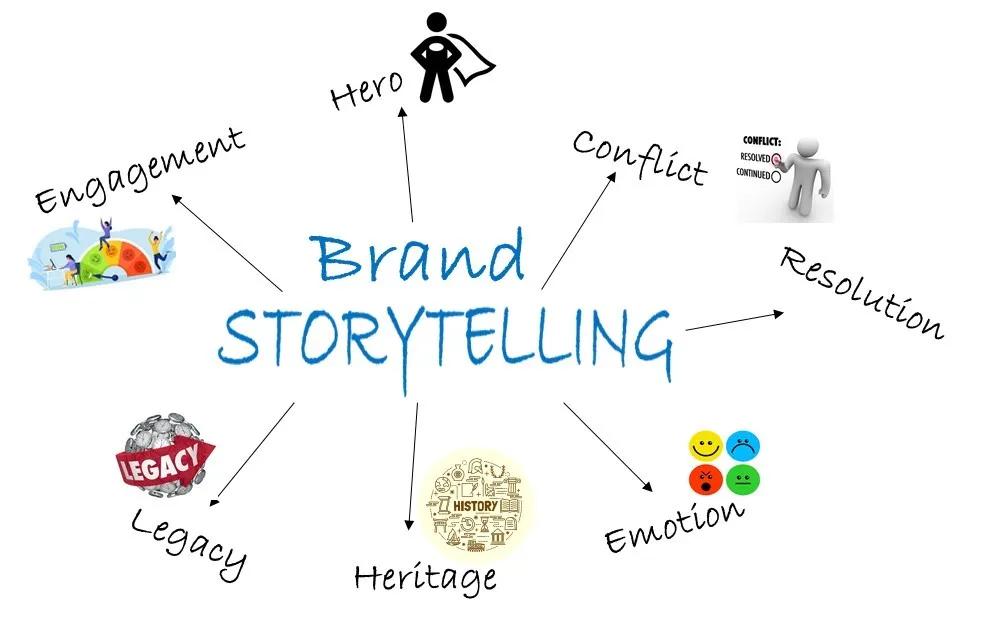Why is Brand Storytelling in Branding and Brand Positioning Important?
Table of Contents

- jaro Education
- 2, April 2023
- 5:48 am
In the current competitive marketplace, all brands are aiming for customers to notice them, but what really distinguishes a successful brand is the strength of storytelling in branding. Today’s audiences no longer bond solely with products or services; they bond with emotions, values, and purpose. Here is where brand storytelling comes into play and has its revolutionary role — assisting companies in conveying who they are, what they believe in, and why they exist.
Powerful brand storytelling creates a human connection, enabling customers to identify with the journey of the brand. It makes a company not just a logo — it’s a credible story that earns loyalty and trust. Strategically executed, storytelling in branding enables brands to communicate authenticity and consistency to all touchpoints, ranging from advertising to customer experience.
Additionally, brand positioning is made stronger by narratives. With storytelling matched with brand values and identity, companies can find a unique place in consumers’ minds. Essentially, brand storytelling is more than simply telling stories — it’s about creating perception, engaging, and reinforcing brand positioning that endures.
With the right story, brands can shift from being known to being remembered — and that’s where true influence starts. In this blog, we will learn what brand storytelling is and all the related aspects of it.
What is Brand Storytelling?
Brand storytelling is the act of using stories to connect with customers and create a connection between the customer and the brand. When done correctly, brand storytelling can be an incredibly powerful tool for building customer loyalty and creating an emotional connection between the customer and the brand.

*GBCI
Importance of Brand Storytelling
There are many reasons why brand storytelling is important in branding and brand positioning, and why it’s taught in management courses. Here are 5 reasons explaining its importance:
1. Helps Stand Out From the Competition
In a world where companies are constantly vying for attention, it’s important to have a strong brand that stands out from the competition. Brand storytelling is one way to achieve this. By creating an engaging story around your brand, you can position yourself in a way that resonates with consumers and helps you stand out from the crowd.
In today’s competitive marketplace, it’s more important to have a strong brand that can cut through the noise. Brand storytelling is one of the most effective ways to achieve this. By crafting a compelling narrative around your brand, you can connect with consumers on an emotional level and create a lasting impression.
2. Humanizes The Brand
People want to connect with brands that feel human. In a world where we are constantly bombarded with marketing messages, it can be difficult for brands to break through the noise and connect with consumers on a personal level.
Brand storytelling humanises the brand, making it feel relatable and trustworthy. When consumers feel like they know the brand, they are more likely to do business with it, and when they have a positive relationship with the brand, they are more likely to be loyal customers.
3. Draws in the Target Demographic
Brand storytelling is all about creating a narrative around your brand that will resonate with your target demographic. When done correctly, brand storytelling can help you connect with your audience on a deeper level, which can ultimately lead to more sales and loyal customers.
It also makes it easier to generate sales, as knowing the target audience is key to generating actionable leads. Instead of marketing to a wider audience, the right kind of brand storytelling can draw in loyal customers and prospective consumers who might resonate more with the brand.
4. Make it Easy to Highlight Brand Value
People often think of brand storytelling as a way to sell more products or services. But it’s much more than that. Brand storytelling is one of the most powerful tools you can use to create a strong brand identity.
A well-told brand story can make your customers feel like they are part of something larger than themselves. It can emotionally connect them to your brand in a way that rational arguments and feature lists never will. Apart from that, it can help them understand and remember what makes your brand unique.
That’s why brand storytelling is so important in branding and brand positioning. It’s not just about making a sale today, it’s about creating an emotional connection that helps in retaining a customer.
5. Offers Control Over the Brand Story
In any management course featuring branding, it is made clear that to create a strong brand, businesses need to be able to control the story that is told about them. This means having a clear and concise message that can be communicated to existing and potential customers. It is important to have a brand story that is compelling and differentiates the business from its competitors, which in turn, will help position the business in the marketplace and build loyalty among its customer base.
Examples Of Successful Brand Storytelling

*Medium
There are many examples of brands that have used storytelling effectively to position themselves in the market and connect with their consumers. Some of these include:
1. Nike
Nike has built its brand around the idea of “Just Do It”, using stories of athletes overcoming adversity, in order to inspire others.
2. Coca-Cola
Coca-Cola has used emotional storytelling in its advertising, from iconic Christmas ads to more recent efforts like the “Share a Coke” campaign.
3. Apple
This brand is built on the idea of innovation and design excellence, and its marketing often tells stories about how its products have changed people’s lives for the better.
Level Up Your Brand Management Skills with the PG Graduate Certificate Programme in Product & Brand Management by IIM Nagpur
Take your marketing and brand skills to the next level with the Post Graduate Certificate Programme in Product and Brand Management from IIM Nagpur, offered with Jaro Education, India’s top EdTech platform for professional development through leading IITs and IIMs. This program helps professionals gain a deep understanding of branding, product innovation, and market positioning. With personalized counseling, expert mentoring, and one-on-one guidance, you will gain the clarity and confidence to make informed career decisions. Whether you want to lead brand strategies, manage product portfolios, or strengthen your marketing leadership, this program gives you the tools, insights, and mentorship to succeed in today’s competitive business world.
Conclusion
Lastly, brand storytelling is the core of effective brand positioning and powerful branding. Beyond products and services, it establishes emotional connections that make brands remembered and credible. With strong storytelling in branding, organizations can form opinions, create loyalty, and differentiate themselves amidst busy markets. In the experience-based world today, it is the brands with authentic, consistent narratives that succeed. Writing your brand’s story purposefully secures sustained engagement and a lasting impression on your audience — converting customers into loyal brand evangelists and narratives into quantifiable success.
Frequently Asked Questions
Storytelling in branding is the skill of sharing a brand’s values, mission, and purpose through engaging stories that connect emotionally with the audience. Good brand storytelling shapes strong brand positioning and fosters long-term loyalty.
A notable example of brand storytelling is Nike’s “Just Do It” campaign. It encourages people to push their limits beyond sports. This effective storytelling in branding strengthens Nike’s brand positioning as a source of courage and empowerment.
The 4 P’s of storytelling in branding are People, Place, Plot, and Purpose. These elements come together to create genuine brand storytelling that enhances emotional appeal and supports consistent brand positioning.
The 7 elements of StoryBrand include a character, problem, guide, plan, call to action, success, and transformation. These components of brand storytelling help brands create clarity, connect deeply with their audiences, and reinforce their brand positioning in the market.










